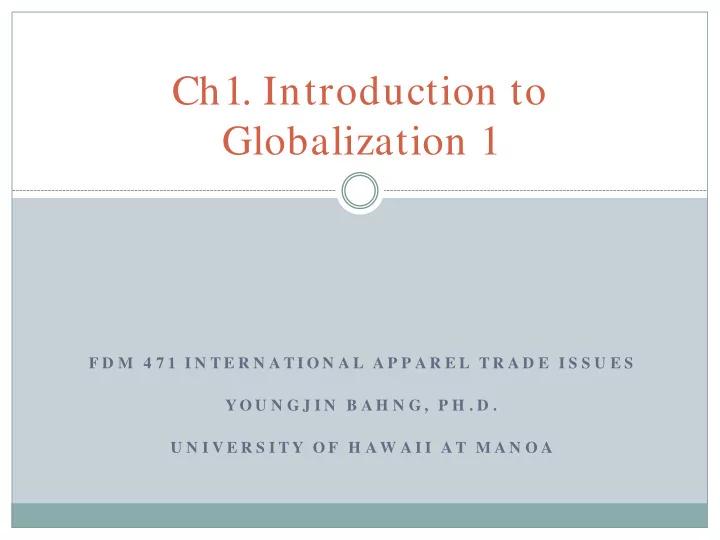

Ch1. Introduction to Globalization 1 F D M 4 7 1 I N T E R N A T I O N A L A P P A R E L T R A D E I S S U E S Y O U N G J I N B A H N G , P H . D . U N I V E R S I T Y O F H A W A I I A T M A N O A
Overview of chapter 1 Globalization Global issues in the apparel and Textile industries Nature of firms in the textile complex Differences among countries developed, developing, newly developing, and least developed
Tips about Reading chapters and Quizzes Before you read through chapters, review “Global Lexicon” When you read the chapters, go back to the Global Lexicon and make sure you are familiar with the definitions of the business-trade words Don’t worry - the number of terms in the Global Lexicon decreases as it goes to the next chapter Many quiz questions will be made based on the words and definitions in the Global Lexicon
Globalization Globalization is the process whereby the world’s people are becoming increasingly interconnected in all facets of their lives—cultural, economic, political, technological, and environmental” (Lodge, 1995) E-commerce is electronic business transactions conducted by systems such as the internet or mobile E-tailing is a type of retailing that consumers can purchase products or services using electronic systems such as the internet or mobile
Perspectives for consideration of globalization The mid 20 th century : apparel and textile products produced within the domestic economy The 1980s – 1990s- 21 st century : source of products changed from domestic to international to multinational to global
Perspectives for consideration of globalization Globalization viewed from Political/government perspectives Economic/business perspectives Social/labor perspectives; including environmental and economic sustainability
Measuring levels of trade Imports make goods available for domestic consumption or materials available for domestic production Exports represent goods shipped for import to another country in exchange for money, other goods, or jobs
Introduction of the Fashion Industry Textile and apparel professionals engage in Merchandising Marketing Design Product development Production Distribution The textile and apparel businesses provide employment for more people than any other business segment (e.g., 35 million in India)
Introduction Cont. Over past 15 years U.S.-based manufacturers, such as VF Corporation and Levi Strauss & Co., have closed dozens of plants in the U.S. and moved them to low- wage countries Between 1980 and 2002, the apparel workforce was cut 56.6 percent
Fashion industry pipeline (Textile complex)
Levels of trade Domestic trade International trade Global trade Trade agreements established by governments to enhance or control trade
Global trade Sourcing determines the most cost-efficient vendor of services, materials, production, or finished goods, at a specified quality and service level, for delivery within an identified time frame Outsourcing is the process of acquiring services, materials, production, or finished goods in foreign countries, or shifting specific operations outside the country
Measuring levels of trade Cont. Trade balance = exports – imports A trade surplus means there is a positive trade balance; a trade deficit means there is a negative trade balance e.g.,) $10M exports - $7M imports = + $3M surplus $5 M exports - $8M imports = - $3M deficit
Recommend
More recommend